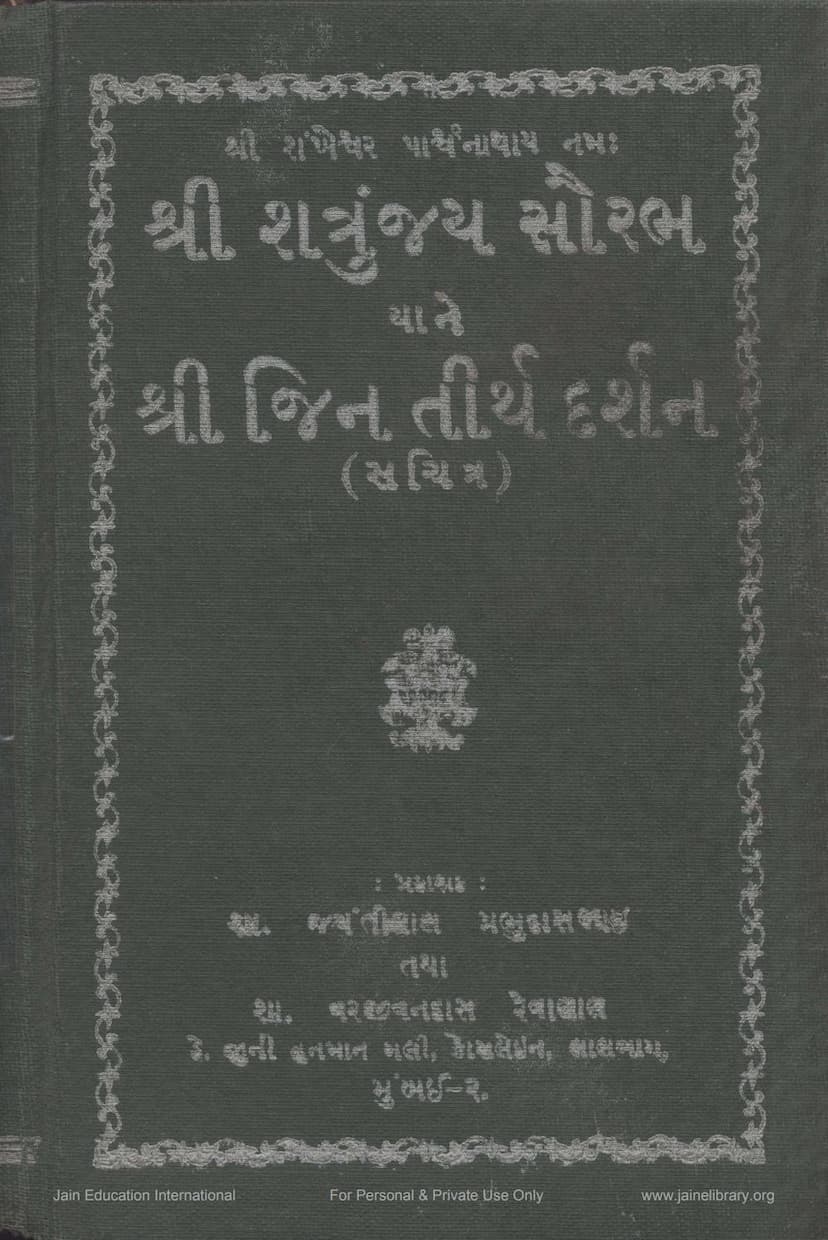Shatrunjay Saurabh Yane Jin Tirth Darshan Sachitra
Added to library: September 2, 2025

Summary
This Jain text, titled "Shatrunjay Saurabh yane Jin Tirth Darshan Sachitra" (Shatrunjay Saurabh, or a Pictorial Guide to Jain Tirthas), authored by Jayantilal Prabhudasbhai and Varjivandas Revalal, and published by Shatrunjay Saurabh, is a comprehensive guide to Jain pilgrimage sites, primarily focusing on the Shatrunjay and Girnar Tirthas.
Key Themes and Content:
-
Spiritual Guidance and Philosophical Foundation: The book begins with profound philosophical reflections on the cyclical nature of existence (samsara) and the immense suffering endured by the soul due to its attachment to external things (parabhav-dasha). It emphasizes the importance of recognizing the true nature of the soul and the essential role of the Tirthankaras (Jineshwar Dev), the Guru, and the Dharma in eradicating sin and attaining spiritual merit. The text highlights the rarity of human birth and the opportunity it presents for spiritual progress.
-
Description of Shatrunjay and Girnar Tirthas: A significant portion of the book is dedicated to providing an overview of the sacred pilgrimage sites of Shatrunjay and Girnar. It describes the idols (pratimaji) of stone and metal housed within the Jain temples at these locations.
-
Journey and Practices: The text outlines the journey from Shatrunjay to Rajnagar, mentioning the number of idols encountered along the way. It also details various aspects of the pilgrimage, including:
- "Chhari" (Sixfold Conduct): The book explains the six crucial practices for undertaking the Shatrunjay pilgrimage: daily one-meal (ekasana), abstaining from water-containing vegetables (sachit parihar), walking barefoot with the Guru (guru sathe padachari), sleeping on the floor (bhuin santhari), observing celibacy (brahmacharya), and performing daily rituals twice a day (aavashyak devvaari - right and evening pratikraman).
- "Navanu Yatra" (Ninety-Nine Pilgrimages): The significance of undertaking 99 pilgrimages to Shatrunjay is explained, linking it to the Tirthankara Rishabhdev's (Adishwar Bhagwan) 99 visits to the site.
- Rules for Pilgrims: Specific instructions are provided for pilgrims, such as starting the journey early in the morning, remembering the Navkar mantra while climbing, respecting the footprints of saints, observing modesty in dress, performing eightfold worship (asht-prakari puja) with pure intentions, making offerings of flowers, and refraining from polluting the sacred sites.
-
Historical Accounts and Royal Devotion: The text narrates historical accounts of the Tirthas, including the renovations and constructions undertaken by various kings, ministers, and wealthy patrons. It highlights the devotion of kings like Samprati Raja, Kumarpal, and Siddharaj, who played significant roles in the preservation and development of these sacred sites. Stories of patrons like Motishah and Jagdusah are also included, showcasing their immense faith and generosity.
-
Detailed Description of Temples and Idols: The book provides an extensive list of temples and idols at Shatrunjay, categorizing them by Tirthas and the individuals who commissioned them. This includes detailed descriptions of various "Tunk" (smaller shrines or temples within the larger complex), their locations, and the principal deities housed within them. It also lists the names of the deities and the number of idols in various sections.
-
Geographical and Historical Context: The text offers geographical details of Shatrunjay, its location in Saurashtra (Kathiawad), and its historical context, including the rise and fall of cities like Vallabhi. It touches upon the impact of invasions and the subsequent efforts for restoration.
-
Biographical Sketches: The book includes brief biographies of prominent Jain Acharyas and monks who were instrumental in the propagation of Jainism and the upkeep of the Tirthas, such as Acharya Vijay Siddhishwarji and Acharya Vijay Meghsuriswarji. Their lives of austerity, scholarship, and devotion are highlighted.
-
Devotional Literature: The text incorporates various devotional songs (bhajans), verses (duha), and hymns (stavan, chaityavandan) dedicated to the Tirthankaras and the sacred sites, particularly Shatrunjay and Girnar. These are intended to aid pilgrims in their spiritual remembrance and connection.
-
Social and Community Institutions: It sheds light on various Jain religious and social institutions established in Palitana, such as the Anandji Kalyanji Pedhi, Jain Gurukuls, Balashrams, Shravikashrams, Gaushalas, and libraries, emphasizing their role in community welfare and spiritual education.
Overall Purpose:
"Shatrunjay Saurabh" serves as a sacred guide for Jain pilgrims, aiming to deepen their understanding of the Tirthas, inspire devotion, and provide practical information for their journey. It connects the physical act of pilgrimage with profound spiritual principles, encouraging a life of righteousness, detachment, and devotion to the Jain faith. The detailed lists of temples, idols, and the historical context underscore the rich heritage and enduring significance of these pilgrimage sites in Jainism.